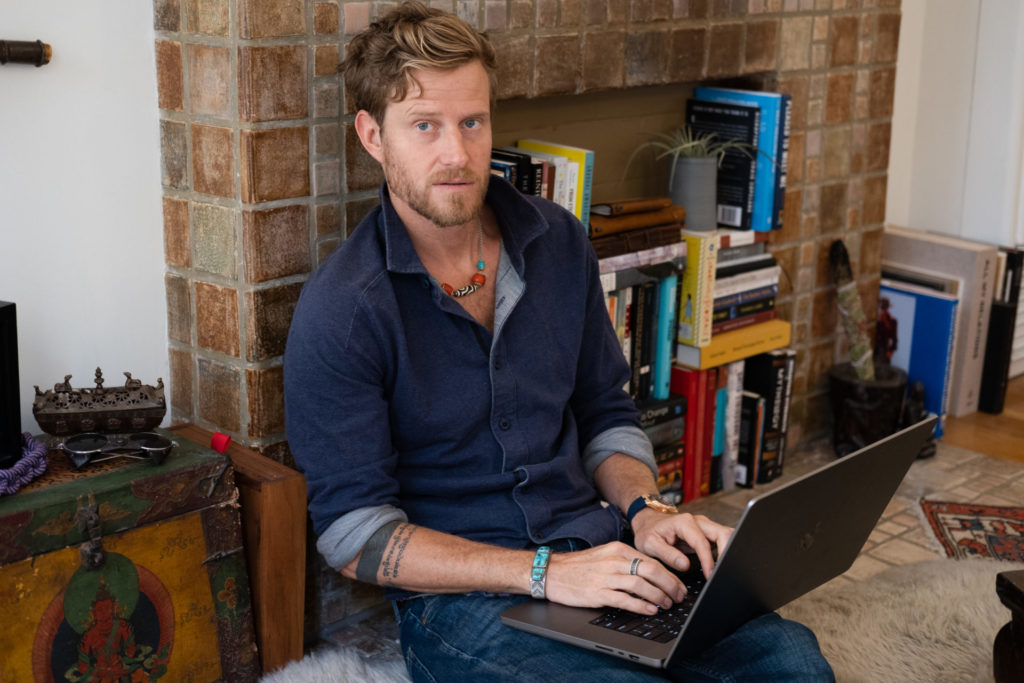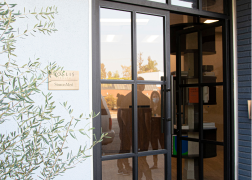When and how were you diagnosed with bipolar disorder?
The odd thing about the journey is that it started very early. My mom actually took me to see a child psychologist when I was one. I don’t know what she saw and it’s debatable if that was healthy or not. What I appreciate about it is her intuition. The messaging that something is wrong with us can be sticky and I think that story has some cautionary tales. Regardless, she felt that something was “off”… she felt I was depressed. I’d probably say that I was just born with my nervous system exposed in a way that predisposed me to be more sensitive… as if my whole structure for feeling the world and interpreting its lessons wasn’t fully formed, like an emotional preemie. That said, my parents did everything they could with the information they had at the time. They tried very hard to navigate the world with and for me in the healthiest ways. And still, there were a host of influences and inescapable stressors that influenced my development. I was a gifted kid and went to high school two years early. But at the onset of adolescence, my neurobiology shifted and things started to unravel fairly quickly. My grades dropped from near perfect to near failing. I was diagnosed with clinical depression at 12. By the time I was 14, I had completely dropped out of school and ended up in eight months of inpatient/outpatient treatment and was ultimately diagnosed as bipolar 2. This was at the time in the 90s when bipolar was a wildly popular diagnosis and I think it’s important to flag that most teens struggle in ways that can be misinterpreted as psychological dysfunction. Regardless, that was the label that was applied and the protocol our family followed as we tried to sort it out.
What sort of treatments have you tried over the years?
A lot of things. In the early years, it was all SSRIs and mood stabilizers. We landed on a cocktail of bupropion and valproic acid (Wellbutrin and Depakote) and I stayed on them for nearly 26 years. The problem with bipolar 2 is its symptoms can be so easily overlooked or over-considered. Once the idea that you suffer from hypomania or mania is taught, it can be hard to trust feeling happy at all, as if it’s a warning sign that you’re escalating out of control. That is dangerous because it ends up with people gaslighting their own positive experiences. More recently, I’ve used lamotrigine to help dull the edges of irritability and anger. I’ve done clinical psychedelic treatments with both ketamine and psilocybin, and have tried microdosing as well. All of these have had important impacts on my overall wellbeing, but I will be the first and loudest to say that psychedelics are not a silver bullet. They are not a cure. They are not a one-stop shop and just because we have an amazing experience and begin to understand and integrate our trauma, it does not mean that we are healed or we’ve “done the work.” Nothing is more irritating to me than when I hear someone say, “I got more out of one psychedelic session than 10 years of psychotherapy.” My answer is, “You got so much out of that session likely because you did 10 years of psychotherapy.” Likewise, there is a movement right now that seems to conflate the understanding of our creation stories for healing. Understanding what happened is only the first step. It helps us form a rough structure around ourselves and our journey with pathologies, behaviors, and mental health as a whole. But the story itself isn’t healing. Knowing why we do something isn’t the end. The end, if there is one, comes when we transcend the story altogether. That is what integration actually means. It means dropping the story because the story no longer informs your actions.

“I had essentially decided that the best way to escape madness was to embrace it and live madly. I was risking my own life in an attempt to save it.”
How has your experience of being bipolar influenced your art as a photographer and storyteller—and how has it affected your career in general?
Oh man. What a gift. What a privilege. What a curse. I think it has opened me up. It has made me more receptive to the fringes of what we show to the world. Exposing that to others in conscious and subconscious ways opens doors to a more real shared experience. I’ve always said vulnerability is the linchpin of great art. But it isn’t one sided. It’s a dance. We give and take and extend and retreat and in doing so make space for a deeper interaction and observation of the world. It’s not good or bad…it’s not right or wrong…and I’m certainly not saying that great art can’t be created in psychological stasis. What I am saying is that the depth of felt sense can be leveraged to explore a more raw expression. And often, that rawness is what “viewers” respond to. So there’s that. Conversely, as I look back on my career, I see many missteps and mistakes that I made from overindulgence and self-righteousness and outsized ego. I could be hard to work with, temperamental, entitled, and angry. I was reactive. I was short-fused. I could be cruel. And there is NO excuse for that kind of behavior. None. Ever. We can look to our struggles for clues that influence our actions. But those clues don’t excuse us from being decent. In short, my emotional landscape has allowed me to be wildly creative in ways that others often can’t. I’m not better. Just different. It has also led me to be wildly miscalculated and behave poorly at times. Unsurprisingly, the experience has been polar.
You’ve also had to deal with PTSD. Can you tell us a little about the avalanche that almost killed you, and how it changed your life afterward?
In the winter of 2011 I was almost killed in an avalanche in Pakistan. We were a team of three climbing one of the highest mountains in the world in winter. By this time, I had essentially decided that the best way to escape madness was to embrace it and live madly. I was risking my own life in an attempt to save it. The avalanche hit us above basecamp as we descended from the summit after six days of climbing. We were fortunate to be hit on flat ground, so the vast majority of the force was from the wind blast that is pushed out in front of big slides. We were all partially buried and I assumed that my partners had died before I heard their voices. It took several years for me to understand, but given the violence that I had experienced during my childhood, the time I’d spent on the street, and all the underlying issues that those experiences cause, my brain was planted and fertilized for a PTSD episode. All it needed was water. And the water came in the form of the avalanche. I was angry and isolated and disassociated, I drank a lot. I forgot things. I sped up in my career and distracted myself and became explosive. I became isolated and gravitated towards sex as a method for tethering myself back to a world I felt I was drifting away from. I did everything I didn’t want to do and couldn’t understand why. And I still did it. And even more disturbing, there were pieces of it I liked. PTSD is so tough because we reserve it for spaces like war. But the brain doesn’t know the difference between an IED in Iraq or a car accident in Minnesota or an avalanche in Pakistan. It’s all the same thing to the mind. Likewise, it doesn’t have to be a singular event. When we have a lot of little traumas in life, PTSD from a big trauma is more likely. But it isn’t certain and just because we don’t have a lot of little traumas doesn’t mean we won’t suffer from PTSD. We have to apprehend it in the symptoms and then work backwards to understand the source. Life changed a lot. And still does. I’ve worked with all sorts of modalities, and I can confidently say the most meaningful acute healing practice was EMDR. And consistent, consistent, consistent meditation. Again, there is no silver bullet. There isn’t a pill. The pill is us. And we have to swallow ourselves every single day if we want to truly heal. It’s wildly confronting.
What did you learn about yourself by facing your PTSD? Did having bipolar disorder prepare you at all? How do the two relate to each other?
Quite simply, I’ve learned that life is messy. It has to be. It will be. I’m messy. I can have all the knowledge in the world, but until I migrate from my head to my heart, until I integrate, the knowledge is meaningless. In some ways, all the “knowing” can get in the way of the healing. Healing is something that is felt. It is governed by the brain, but experienced in the body. We have to change ourselves in order to heal, but the wounds we endure often end up defining our stories, which makes it incredibly hard to change! It’s a cruel irony that owning our stories is often what creates a cage that holds us in our trauma. Bipolar taught me to be cautious in my certitude. And that lesson carried over into trauma. Our minds like certainty and truth and duality. But nothing really exists that way. Having lived a full life as “bipolar,” I learned to temper my passions and allow space between intellectual conclusion and outward action. In short, the two are related at a very basal level. Trauma is the root of almost all psychological dysfunction. Take a second for that to sink in. We aren’t born bipolar. We are born with genetic predispositions and a roadmap, but it’s trauma and toxic stress that ignite those genes into action and reaction. That is what the best science of the day tells us. So PTSD is just another weed from the same seed. If we can start to see mental health in this way, I think there is hope. The symptoms lead us back to the soil and unless we get the roots out, the weeds will always grow back.
“Nothing is more irritating to me than when I hear someone say, ‘I got more out of one psychedelic session than 10 years of psychotherapy.’ My answer is, ‘You got so much out of that session because you did 10 years of psychotherapy.” There is no silver bullet. There isn’t a pill. The pill is us. And we have to swallow ourselves every single day if we want to truly heal.”
Why do you think talking about these things is so rare in the alpha culture of adventure sports?
Because we have enormous egos and it’s scary to say, “I’m hurt. I’m scared. I don’t know what to do. I’m uncertain of everything. I don’t have it all figured out.” Even in a new era where men are encouraged to discuss their feelings openly, there is still a foundational adherence to “traditional” ideas of what strength and masculinity are and look like. And for men and women alike, the idea of vulnerability is often incompatible with those deeply held archetypes. I can’t tell you how many relationships I’ve been in (romantic and platonic) where people have expressed a deep discomfort around men who emote openly. In the adventure sports community, that is amplified because the structure of these activities is built on ego, no matter what fancy words an athlete finds to move around that. It’s true. And just saying that is scary for some.
What inspired you to become such an outspoken advocate for mental health?
Because no one should have to hurt in isolation. End of story.
What do you think people misunderstand about conditions like bipolar disorder and PTSD?
Because these things are unseen, they are hard for others to understand. But I’ve learned that I can’t ask people to understand. What we need is for people to believe. Just believe. We never question when someone says, “I have Parkinson’s.” Or “I broke my femur.” We see it, accept it, and accommodate for it. The same courtesy needs to be extended to mental health. But this requires those suffering to be vigilant in their own self accounting as well and not use their struggles as excuses for poor behavior. It takes both sides to understand that just because something isn’t physically seen, does not mean it isn’t there. And in truth, we can see it. It’s just not physical. It’s worn on the face and heard in the voice. It’s seen in the action and reaction. It’s understood in expression if we take the time first to believe and then to watch.
Where are you at in your battle with this stuff these days? Have you discovered any surprising/useful alternative therapies in your travels around the world?
Today? Well on this particular Wednesday, I’m pretty great. I keep waking up and even though I’m older and less certain of most things, I feel my grasp on the world loosening in the most beautiful ways. Some days are hard. Some weeks are hard. But truthfully, that is just part of it. We have hurdles in relationships and family, work and goals… it’s all just normal. It’s not a battle. It’s a journey. They aren’t adversaries to be subdued, but companions to be learned from. The most useful therapy is the one that no one wants to do because it requires work. It’s also the one that is found to be the most transformative and global. It is the same everywhere you go. It is unchanging and as old as our lungs themselves. Meditation.
How has Sollis been able to streamline your care?
Mental health experts are hard to access and hard to vet. Sollis was a great guide in that process and helped me find a psychiatrist I love.
Any good words to live by?
Stop looking outside yourself to heal. Stop looking outside yourself for the profound. The only salve comes from within. The most profound thing in this world is that we wake up every morning and get to do it again.
“The most profound thing in this world is that we wake up every morning and get to do it again.”







